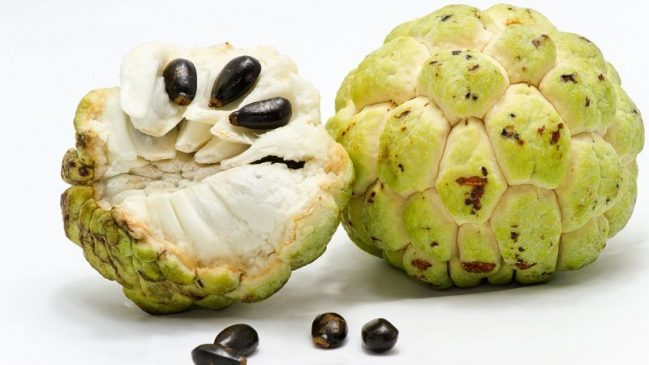Now that we are officially entering the season of air pollution, there is one seasonal fruit that we can rely upon to boost our lung health. It is the creamy and luscious custard apple. It is believed to be rich in vitamin B6 or pyridoxine, which suppresses inflammation of the bronchial tubes that go to the lungs. That is why all asthmatics must have it during a changeover or pollen season. Ingesting the fruit is the most natural way of cleansing your lungs. In fact, the custard apple tree growing by the roadside has been found most resistant to air pollution, according to most studies.
Also known as Sitaphal or Sharifa in India, used for ages in folklore remedies and ayurvedic medicine, the health benefits of custard apple are being proven in various research studies now. The fruit, roots, leaves, bark and flesh are all used for their therapeutic properties.
But the many benefits get hidden by the fact that the fruit is sweet and, therefore, thought to be risky for diabetics or even those having cardio-vascular issues. But the total calorie count from a 100 g custard apple is 94 calories. Proteins are 2.1 gm, dietary fibres go up to 4.4 gms, total fat is 0.0 gms and carbohydrates are at 23.6 gms.
It has a moderate glycaemic index of 54 but a glycaemic load of 10.2. Given its multiple benefits, this works in diabetics if they keep to moderate or limited prescribed quantities. Custard apples are bestowed with polyphenolic antioxidants. These vastly elevate insulin production and glucose absorption, thereby keeping diabetes in check. Nutritionists advise consuming the fruit in small slices and including it in a meal, maybe in oatmeal, yogurt and smoothies, rather than eating it separately. The fruit increases the muscular uptake of glucose, thereby enhancing its peripheral utilisation. Since 20 mg vitamin C is present in 100 gm of custard apple, it impacts insulin production and helps reduce blood sugar. Also, magnesium, potassium and iron indirectly affect insulin production and thus control blood sugar. The rich fibres and seeds, which need to be pried open and had, cause slow digestion, build satiety, reduce snack cravings and keep sugar levels low.
Besides, the fruit can be had as a dessert, which would have done more harm than good.
There is a variety of custard apples available. Some typical varieties are Annona squamosa (Sitaphal), Bull’s heart fruit (Ramphal), Cherimoya (Lakshmanphal) and Soursop (Hanumanphal).
Get started with the fruit
The caloric content of custard apple is twice as much as an apple, which makes it an excellent energy replenisher. It provides an extensive amount of potassium, which helps in eliminating muscle weakness and improves blood circulation.
Keeps BP at bay
Custard apple consists of a well-balanced ratio of sodium and potassium which helps to regulate and control blood pressure fluctuations in the body. One small custard apple meets almost 10 per cent RDA (recommended dietary allowance) for magnesium that relaxes the heart muscles and reduces the risk of stroke.
Friend of the gut
A custard apple prevents ulcers, stomach problems and acidity owing to its anti-inflammatory properties. Just a 100 gm fruit contains 2.5 times more fibre than an apple and half the vitamin C of an orange. Also, its high magnesium helps in maintaining good bowel movements.
Calms you down
Custard apples are high in antioxidants, which protect our bodies from the damaging effects of free radicals, reduce oxidative stress and prevent diseases like cancer and coronary heart disease. Recent research on custard fruit leaves suggests that they may have anti-inflammatory, anti-tumour, anti-obesity, antioxidant, antiviral, and anti-microbial properties. The fruit provides B Complex vitamins. Thiamine, Riboflavin, Niacin, Vitamin B6 are present. These B complex vitamins control the brain’s GABA (gamma-aminobutyric acid) neuron chemical levels, which regulate our emotions, including depression and stress. Thus, vitamin B also helps you calm down. Everyone enjoys the fruit, but it may be messy and dangerous, especially for young children because eating the seeds unintentionally can cause choking. It is, therefore, preferable to use a masher to remove the seeds.
This delicious fruit is your greatest pal if you have lactose intolerance or are a vegan. And can be a wonderful plant-based alternative for dairy-based creams, condensed milk, caramel sauce and cream cheese in shakes, ice cream, cheese cakes as well as a few Indian desserts. A great festive season of conscious indulgence.



































